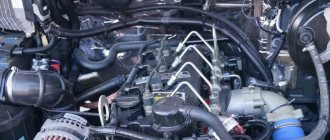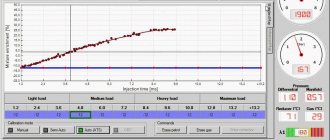I calculate the average fuel consumption for each refueling. Methane consumption in cubic meters per 1 km:
The average is 7.5 cubic meters per 100 km
Gasoline consumption in liters per 1 km
On average it turns out to be 1 liter per 100 km
Lately I haven’t been heating it up - within 10 seconds after I started the food, so the gas mileage has increased and the methane has dropped. If you wait until it switches to methane and then drive, then when you leave the yard you can stall, which is dangerous, so I leave on gasoline and on the road it already switches to gas, which is not so scary.
At the moment, the mileage is 19,748, of which 9,282 rubles were spent on gasoline and 26,170 rubles on methane - the average consumption is 1.8 rubles per 1 km
Price: 35,450 ₽ Mileage: 19,750 km
What are the advantages of the methane version of Lada Vesta
The first samples of the modified car were presented by the plant in mid-2014 and caused a sensation due to the presence of a foreign-made factory gas installation and the possibility of using two fuel systems. Mass production of the model range started only in 2022.
The advantages of the methane version are:
- bringing the toxicity level to international standards;
- significant reduction in fuel costs (subject to the use of gas equipment);
- increasing the travel distance to 1000 km on a full tank;
- greater safety of methane compared to propane and butane;
- less wear of power plant mechanisms.
One of the main advantages, of course, is considered to be efficiency, especially when it comes to regular use of the car and driving long distances. This model has no external differences from the previous version, except for special markings in the trunk area, indicating that the car uses methane. Convenient for daily use, front-wheel drive sedans and station wagons are distinguished by a slightly higher price due to the dual-fuel system. However, economical fuel consumption and a lower price for methane offset this fact.
What is the difference between propane and methane. The principle of operation of a methane engine
Propane and methane are gas-fuel substances that have the same purpose, but fundamentally different characteristics. Propane is a product of the oil industry, while methane is classified as a natural gas. When used as fuel for HBO, both gases are placed in cylinders, the thickness of the walls of which also depends on the substance for which they are intended.
Liquefied propane does not require excessively high pressure when filling the cylinder; accordingly, the walls of the propane storage are not too dense (4-5 mm). Methane is used only in gaseous form, and its pressure reaches extremely high levels. Methane cylinders are much larger in size, their walls are strong (2-3 cm). During combustion, methane is harmless to the environment, which is why it is recognized by world standards as the most environmentally friendly combustible fuel. The most important difference between the two categories of gases is the degree of their safety for the driver and passengers of the car. Methane, unlike propane, is light, which allows the substance to evaporate (if it leaks) before creating an explosive situation. Since methane has no color or odor, the gas is diluted with specific odorants that make it possible to identify a leak. In Russia, the lion's share of car owners prefer installing propane gas equipment due to its lower cost and the relative lightness of fuel cylinders. Methane equipment is much more expensive, but the price of methane, its environmental friendliness and operational safety cover this disadvantage. A methane engine operates on the same principle as a gasoline engine (the compressed mixture is ignited by an energy source) with one fundamental difference - an increased level of compression. The fuel supply source is a gas cylinder, which is installed in the trunk of the car and is equipped with a special valve, through which both the equipment is refueled and gas is supplied to the system.
Technical characteristics of Lada Vesta on methane
Lada Vesta CNG is equipped with a 1.6 liter dual-fuel engine and a five-speed manual transmission. The maximum speed when using gasoline is 175 km/h, gas – 170 km/h. The power of the power plant when driving on gasoline is 106 kW. When switching to methane, the figures drop to 96 kW.
The gas fuel refill compartment is located directly behind the gas tank hatch. The modified version of the car is equipped with a factory-installed Italian-made gas system; a 90-liter gas cylinder is located behind the rear seats. To increase the safety level of the tank, the cylinder is equipped with high-speed valves and a special fuse that prevents it from rupture and methane leakage. This arrangement of the volumetric cylinder significantly reduced the available space in the luggage compartment and made it impossible to transform the rear row of seats. Significant advantages were the absence of the need for maintenance of the gas reducer, fuel rail and the long service life of the cylinder (15 years). When ignited, this model uses exclusively gasoline fuel, after which the vehicle automatically switches to gas. Manufacturers have provided another important automated process - switching from gasoline to methane, in the case of the end of the former in the tank. The Lada Vesta functionality includes the ability to manually switch work from gasoline to gas and vice versa. The car accelerates to a speed of 100 km/h (when using gasoline) in 11.8 seconds. methane slightly increases these figures to 13c. The average methane consumption is 6.3 m3. Otherwise, the modified model is no different from its predecessor.
Installation and Maintenance
Converting a gasoline version into a hybrid version, according to experts, will cost from 30 thousand to 170 thousand rubles. But due to the fact that the state provides financial support, the factory model will be only 30 thousand more expensive than a regular gasoline model. This leads to another disadvantage of LPG - it does not begin to make a profit immediately, since its installation requires serious investments. Therefore, equipping a car with such systems is carried out taking into account the future, and not immediate payback.
Maintenance of this type of equipment is not much different from any other and will not hit the driver’s wallet. Typically, the working life of all gas equipment parts has a serious reserve and, with proper installation and operation, can serve the owner for a very long and productive time. In addition, I would like to note that the Lada Vesta with gas equipment has many positive reviews.
Note! You should not save money on specialists if you bought a Lada Vesta with LPG not from the factory, but install it yourself.
Prices and modifications of Lada Vesta on methane
At the present stage, the methane Lada Vesta is available in the following trim levels:
Comfort – manufacturers have added a number of additional functions to the basic configuration: expanded ability to adjust the driver’s seat, parking sensors, and a fairly powerful audio system. The price of the modification is about 640 thousand rubles.
The Luxe version includes power windows for the rear windows, additional side airbags, and sensors that respond to light and rain. Among other things, the version is equipped with alloy wheels with a diameter of 16 inches. For this modification, manufacturers ask from 700 thousand rubles.
Luxe Multimedia is the most expensive modification (from 730 thousand rubles). This version is equipped with a built-in navigation system, a 7-inch touch screen, six high-quality speakers, and multifunction steering.
Possible malfunctions and how to fix them
| Malfunction | Remedy |
| System depressurization | Replacing pipes, adapters, fittings with new ones |
| Control unit malfunction | Flashing, debugging with a portable scanner using a diagnostic connector |
| Gas level sensor errors | Replacing the sensor with a new one |
| Failure of the valve-regulator | Replacement with new one |
Registration of the methane version of Lada Vesta with the Traffic Police
Lada Vesta CNG is a model range serially modified for LPG. The registration procedure for the methane version of the Lada Vesta does not differ significantly from the registration of the gasoline version. The vehicle's passport must initially contain a note stating that the car's engine is dual-fuel, but the registration certificate (CTC) may not contain a record of gas equipment. However, it is better for the car owner to insist that the STS and special notes must include a clause regarding the presence of LPG.
Deciding on the generation of HBO and its manufacturer
The decision which generation of HBO to choose, first of all, depends on the financial capabilities of the driver, however, if we consider the most favorable generation of HBO for Vesta, then it will certainly be the fourth. This is due to the fact that the engine of this car model has a simple design and does not require high-tech equipment.
You might be interested >> Gas equipment for Pajero 4
Earlier versions can also be installed on cars, but they are less advanced, and the fifth generation is designed for installation in vehicles equipped with turbocharged engines that use direct fuel injection technology. And since such engines are not used when assembling the Lada Vesta, there is no point in installing the 5th generation.
As for the choice of manufacturer, it all depends on the financial capabilities of the driver and the individual requirements that he will place on LPG. As a piece of advice, below are 5 companies whose products are in greatest demand in the gas equipment market:
- Italian company Lovato. The equipment has a reasonable price and is reliable during operation. It is very popular both in the Russian and foreign LPG markets.
- Dutch PRINS. Considered one of the most elite brands; A distinctive feature is the development of injection systems using exclusive technologies.
- Polish STAG equipment. It has a convenient menu translated into Russian and an optimal price-quality ratio.
- Turkish company ATIKER. It is very popular in its homeland and is in serious demand in other countries. The equipment has a high build quality and is constantly tested to ensure compliance with the latest quality and safety standards.
- Italian brand BRC. A distinctive feature is the long working life of the manufactured equipment and one of the longest warranty periods of service among all gas equipment manufacturers on the world market.
Pros and cons of methane Lada Vesta
Lada Vesta on methane is endowed by the manufacturer with many advantages:
- modern equipment;
- technical characteristics that make the car the best option for daily use;
- built-in HBO;
- maneuverability, good visibility;
- efficiency due to the use of methane, which is much cheaper than gasoline;
- relatively low price;
- function of manual and automatic switching from gas to gasoline and back;
- pleasant external and internal design.
However, in addition to the advantages, the car has a number of disadvantages:
- small luggage compartment volume;
- lack of ability to fold down the rear seats;
- low number of methane filling stations;
- the need to use a special adapter for gas filling;
- manual transmission.
On one of the forums on automotive topics, I published a topic about CNG, and what started here... CNG, etc.
Me: I bought a bi-fuel Lada Vesta CNG for work. Consumption on the highway in terms of methane per money is 1r/1km. I wrote in more detail on Drive: www.drive2.ru/r/lada/493820359921893394
Forum: 1.gas consumption 12-14 l/100 km. the average price of gas is 20 rubles liter, so count it. (Me: apparently confused with propane...) 2. for 750 it’s normal... It’s amazing that the welfare of the people is growing))) I missed a lot))) (Me: I agree that it’s a little expensive, but I bought the maximum speed for 677,430 rubles and am happy as an elephant!) 3. Even if we leave aside the astronomical price of a Zhiguli... Methane... Why? Meaning? The savings compared to propane are simply ridiculous... Well, how much? Well, 5 thousand rubles a year? There is excellent equipment for propane, the same BRC. If something happens, you can get service in any city in Russia and Europe... Propane gas stations are everywhere... both in Russia and in Europe... Methane gas stations are probably 100 times less...
Yes, is it true that you also had to buy an adapter for refueling for 5,000 rubles? (Me: 1. I bought a car for work. 2. How long can you live in the past? A car that has everything you need (maximum configuration) cost me 677,430 rubles. That’s $12,000. The question is what new car can you buy for this money? Don’t tell me about rotten, farted, 18-year-old T4, etc. 3. The savings compared to gasoline and propane in money are significant, about diesel, I’m generally silent. Here is a calculation of the cost of km from a person from the forum:
“Yesterday I filled up both gasoline and Methane at the gas station in Inkerman. From 666 km (a full refueling with methane and gas was also in Inkerman) to 3689 km, 21.83 liters of gasoline were consumed. on the same run, a total of 242.66 cubic meters of methane was consumed. Mileage = 3023 km. Those. on average it comes out to 242.66/3023*100=8.03 cubic meters per 100 km 21.83/3023*100=0.72 liters per 100 km In terms of money at the moment: 8.03*18+0.72*43.89=176 rubles/100 km »
In my case, the car will be used mainly on the highway as a delivery vehicle, methane consumption is expected to be 6-7 cubic meters per 100 km. That at a methane price of 15 rubles per cubic meter it will be 105 rubles per km. We budgeted for maximum costs for gasoline, heating, etc. For highway mileage, the money consumption will be a maximum of 150 rubles/100 km.
Until this point, these functions were performed by the Opel Mokka and sometimes the T5.
The average annual mileage of the Opel Mokka was 35t.km per year with an average consumption of 95th gasoline 35t.km*80l.*41r/l= 115t.r. (provided that gasoline does not rise in price to 50r/l after the elections...)
Advantages and disadvantages of CNG
| Advantages | Flaws |
| Real savings on fuel | Few gas stations |
| High maximum idle speed | Little space in the luggage compartment (240 l) |
| Refueling with methane is much faster than analogues | Gas cylinder weight (75 kg) |
| Safety of gas equipment for the driver and passengers | No covers on fuel pipes |
| Economical | The spare wheel is paved under the gas cylinder |
| Affordable price | Lack of fitting - adapter for refilling |
| One type of gearbox |
Related link:
Armrests for Lada Vesta: review, modifications, characteristics, installation recommendations











